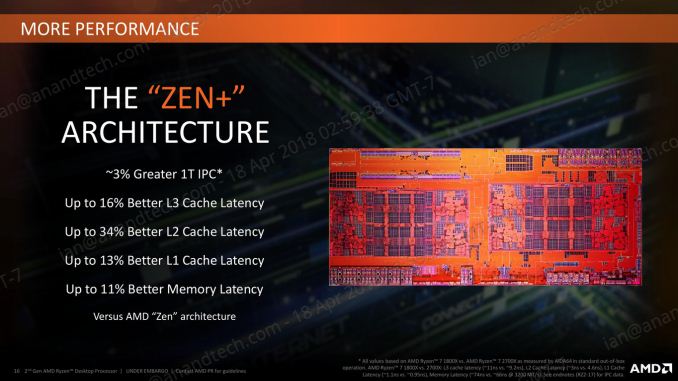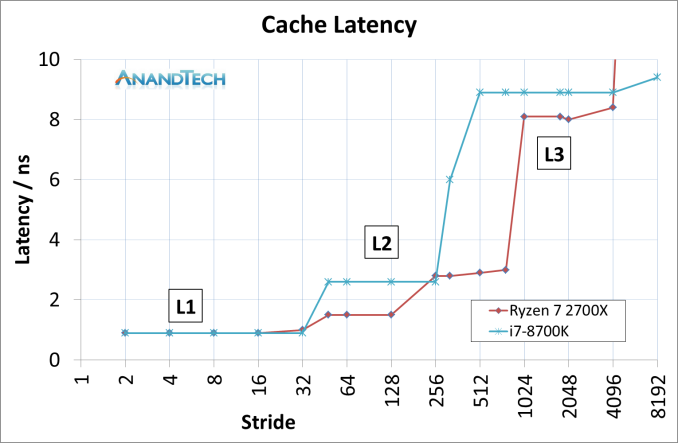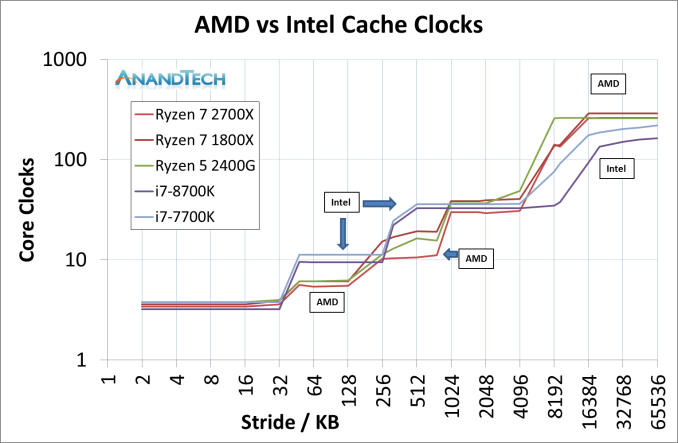The AMD 2nd Gen Ryzen Deep Dive: The 2700X, 2700, 2600X, and 2600 Tested
by Ian Cutress on April 19, 2018 9:00 AM ESTImprovements to the Cache Hierarchy
The biggest under-the-hood change for the Ryzen 2000-series processors is in the cache latency. AMD is claiming that they were able to knock one-cycle from L1 and L2 caches, several cycles from L3, and better DRAM performance. Because pure core IPC is intimately intertwined with the caches (the size, the latency, the bandwidth), these new numbers are leading AMD to claim that these new processors can offer a +3% IPC gain over the previous generation.
The numbers AMD gives are:
- 13% Better L1 Latency (1.10ns vs 0.95ns)
- 34% Better L2 Latency (4.6ns vs 3.0ns)
- 16% Better L3 Latency (11.0ns vs 9.2ns)
- 11% Better Memory Latency (74ns vs 66ns at DDR4-3200)
- Increased DRAM Frequency Support (DDR4-2666 vs DDR4-2933)
It is interesting that in the official slide deck AMD quotes latency measured as time, although in private conversations in our briefing it was discussed in terms of clock cycles. Ultimately latency measured as time can take advantage of other internal enhancements; however a pure engineer prefers to discuss clock cycles.
Naturally we went ahead to test the two aspects of this equation: are the cache metrics actually lower, and do we get an IPC uplift?
Cache Me Ousside, How Bow Dah?
For our testing, we use a memory latency checker over the stride range of the cache hierarchy of a single core. For this test we used the following:
- Ryzen 7 2700X (Zen+)
- Ryzen 5 2400G (Zen APU)
- Ryzen 7 1800X (Zen)
- Intel Core i7-8700K (Coffee Lake)
- Intel Core i7-7700K (Kaby Lake)
The most obvious comparison is between the AMD processors. Here we have the Ryzen 7 1800X from the initial launch, the Ryzen 5 2400G APU that pairs Zen cores with Vega graphics, and the new Ryzen 7 2700X processor.
This graph is logarithmic in both axes.
This graph shows that in every phase of the cache design, the newest Ryzen 7 2700X requires fewer core clocks. The biggest difference is on the L2 cache latency, but L3 has a sizeable gain as well. The reason that the L2 gain is so large, especially between the 1800X and 2700X, is an interesting story.
When AMD first launched the Ryzen 7 1800X, the L2 latency was tested and listed at 17 clocks. This was a little high – it turns out that the engineers had intended for the L2 latency to be 12 clocks initially, but run out of time to tune the firmware and layout before sending the design off to be manufactured, leaving 17 cycles as the best compromise based on what the design was capable of and did not cause issues. With Threadripper and the Ryzen APUs, AMD tweaked the design enough to hit an L2 latency of 12 cycles, which was not specifically promoted at the time despite the benefits it provides. Now with the Ryzen 2000-series, AMD has reduced it down further to 11 cycles. We were told that this was due to both the new manufacturing process but also additional tweaks made to ensure signal coherency. In our testing, we actually saw an average L2 latency of 10.4 cycles, down from 16.9 cycles in on the Ryzen 7 1800X.
The L3 difference is a little unexpected: AMD stated a 16% better latency: 11.0 ns to 9.2 ns. We saw a change from 10.7 ns to 8.1 ns, which was a drop from 39 cycles to 30 cycles.
Of course, we could not go without comparing AMD to Intel. This is where it got very interesting. Now the cache configurations between the Ryzen 7 2700X and Core i7-8700K are different:
| CPU Cache uArch Comparison | ||
| AMD Zen (Ryzen 1000) Zen+ (Ryzen 2000) |
Intel Kaby Lake (Core 7000) Coffee Lake (Core 8000) |
|
| L1-I Size | 64 KB/core | 32 KB/core |
| L1-I Assoc | 4-way | 8-way |
| L1-D Size | 32 KB/core | 32 KB/core |
| L1-D Assoc | 8-way | 8-way |
| L2 Size | 512 KB/core | 256 KB/core |
| L2 Assoc | 8-way | 4-way |
| L3 Size | 8 MB/CCX (2 MB/core) |
2 MB/core |
| L3 Assoc | 16-way | 16-way |
| L3 Type | Victim | Write-back |
AMD has a larger L2 cache, however the AMD L3 cache is a non-inclusive victim cache, which means it cannot be pre-fetched into unlike the Intel L3 cache.
This was an unexpected result, but we can see clearly that AMD has a latency timing advantage across the L2 and L3 caches. There is a sizable difference in DRAM, however the core performance metrics are here in the lower caches.
We can expand this out to include the three AMD chips, as well as Intel’s Coffee Lake and Kaby Lake cores.
This is a graph using cycles rather than timing latency: Intel has a small L1 advantage, however the larger L2 caches in AMD’s Zen designs mean that Intel has to hit the higher latency L3 earlier. Intel makes quick work of DRAM cycle latency however.














545 Comments
View All Comments
peevee - Thursday, April 26, 2018 - link
I mean, Octane test in Chrome is what V8 javascript compiler does. And it itself is build with MSVC AFAIR.Dragonstongue - Thursday, April 26, 2018 - link
just looking back at this, you say according to title 2700x-2700-2600x-2600 and yet in most tests are only listing the results for 2700x-2600x..not good for someone really wanting to see the differences in power use or performance comparing them head to head sort of speak.seems the 2700 would be a "good choice" as according to the little bit of info given about it, it ends up using less power than the 2600 even though rated same TDP with 2 extra core 4 extra threads O.O
I do "hope" the sellers such as amazon at least for us Canadian folk stick closer to the price they should be vs tacking on $15-$25 or more compared to MSRP pricing, seems if one bought them same day of launch pricing was right where it should be.
1600 has bounced around a little bit whereas 1600x is actually a fair price compared to what it was "very tempting" though the lack of a boxed cooler is not good.....shame 2600 only comes with wraith stealth instead of spire seeing as the price is SOOO close (not to mention at least launch price vs what the 1xxx generation is NOW, AMD should have been extra nice and bundled the wraith spire for 2600-2600x and wraith LED and wraith max or whatever for the 2700-2700x
I would imagine if they decide to do a 4 core 8 thread 2xxx that would be the spot to use the wraith spire (less heat load via less cores type deal)
29a - Thursday, April 26, 2018 - link
Not trying to be sarcastic but will this article be finished? I really wanted to read the storage and chipset info. If the article is as complete as it is going to get please let us know, 20 year reader asking.John_M - Saturday, April 28, 2018 - link
I'm sure it will be finished one day but I agree that it doesn't seem so at the moment. If you want to find out about StoreMI AMD has a page about it: https://www.amd.com/en/technologies/store-miET - Tuesday, May 1, 2018 - link
I think we've got ourselves a race: which will get here first, the missing parts of the 2nd gen Ryzen review, or new Raven Ridge drivers? Or perhaps hell will freeze first.29a - Friday, May 4, 2018 - link
Sadly it appears as though the article will not be finished. This site was great during about its first 15 years of existence, Purch has done a thorough job of purching it up.jor5 - Tuesday, May 8, 2018 - link
Oh dear what an embarrassing end to this article.Tuck it away under "what was I thinking??" and pretend it never happened.
x0fff8 - Wednesday, May 9, 2018 - link
is this article ever gonna get updated with the new benchmarks?MDD1963 - Thursday, May 10, 2018 - link
And just like that, my 7700K is fast again! :)peevee - Thursday, May 10, 2018 - link
"Technically the details of the chipset are also covered by the April 19th embargo, so we cannot mention exactly what makes them different to the X370 platform until then"That was written for the article published April 19th, and as of May 10th STILL in the text.